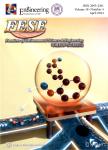Trends of chemical speciation profiles of anthropogenic volatile organic compounds emissions in China, 2005-2020
Trends of chemical speciation profiles of anthropogenic volatile organic compounds emissions in China, 2005-2020作者机构:Department of Environmental Science and Engineering Beijing University of Technology Beijing 100124 China School of Environment State Key Joint Laboratory of Environment Simulation and Pollution Control (SKLESPC) Tsinghua University Beijing 100084 China
出 版 物:《Frontiers of Environmental Science & Engineering》 (环境科学与工程前沿(英文))
年 卷 期:2014年第8卷第1期
页 面:27-41页
核心收录:
学科分类:0830[工学-环境科学与工程(可授工学、理学、农学学位)] 081704[工学-应用化学] 07[理学] 08[工学] 0817[工学-化学工程与技术] 070602[理学-大气物理学与大气环境] 070303[理学-有机化学] 0706[理学-大气科学] 0703[理学-化学]
基 金:国家自然科学基金 Ph.D Programs Foundation of Ministry of Education of China MEP's Special Funds for Research on PublicWelfares
主 题:volatile organic compounds (VOCs) chemi-cal speciation ozone formation Photochemical OzoneCreation Potential (POCP) China
摘 要:This study estimates the detailed chemical profiles of China's anthropogenic volatile organic com- pounds (VOCs) emissions for the period of 2005-2020. The chemical profiles of VOCs for seven activity sectors are calculated, based on which the Photochemical Ozone Creation Potential (POCP) of VOCs for these sectors is evaluated. At the national level, the VOCs species emitted in 2005 include alkanes, alkenes and alkynes, aromatic compounds, alcohols, ketones, aldehydes, esters, ethers and halocarbons, accounting for 26.4wt.%, 29.2wt.%, 21.3 wt.%, 4.7 wt.%, 5.4 wt.%, 1.7 wt.%, 2.1 wt.%, 0.7 wt. % and 2.2wt.% of total emissions, respectively. And during 2005-2020, their mass proportions would respec- tively grow or decrease by - 34.7%, -48.6%, 108.5%, 6.9%, -32.7%, 7.3%, 65.3%, 100.5%, and 55.4%. This change would bring about a 13% reduction of POCP for national VOCs emissions in the future. Thus, although the national VOCs emissions are expected to increase by 33% over the whole period, its ozone formation potential is estimated to rise only by 14%. Large discrepancies are found in VOCs speciation emissions among provinces. Compared to western provinces, the eastern provinces with a more developed economy would emit unsaturated hydrocarbons and benzene with lower mix ratios, and aromatic compounds except benzene, oxidized hydrocar- bons and halocarbons with higher mix ratios. Such differences lead to lower POCP of VOCs emitted in eastern provinces, and higher POCP of VOCs emitted in western provinces. However, due to the large VOCs emissions from Chinese eastern region, the ozone forma- tion potential of VOCs emission in eastern provinces would be much higher than those in western provinces by about 156%-235%.



